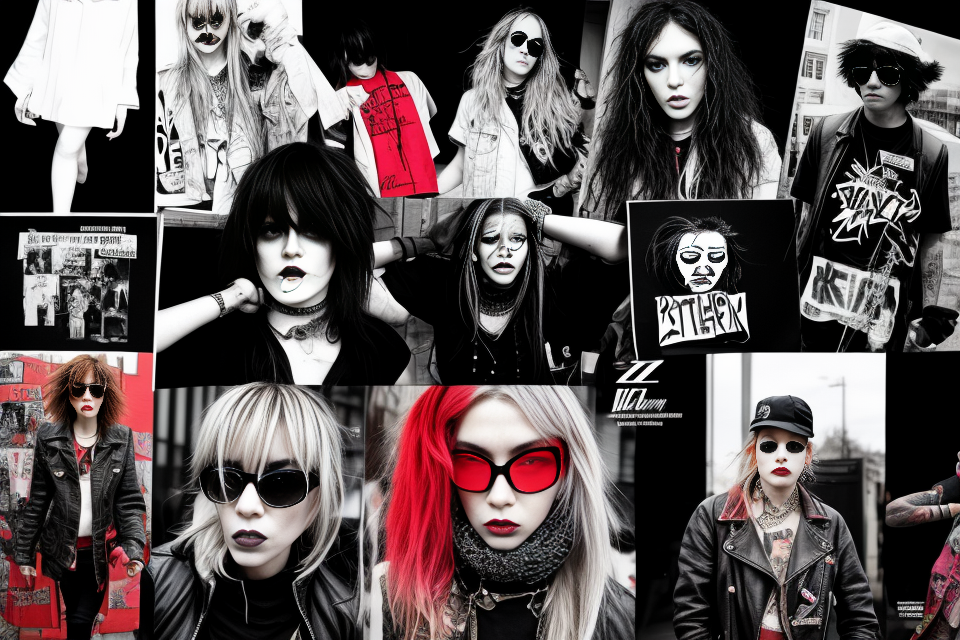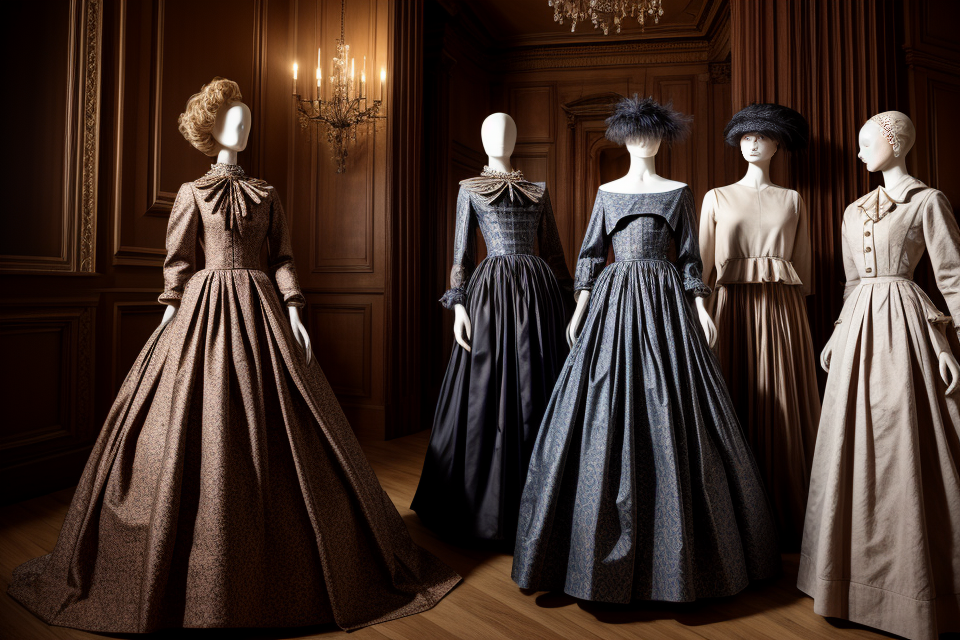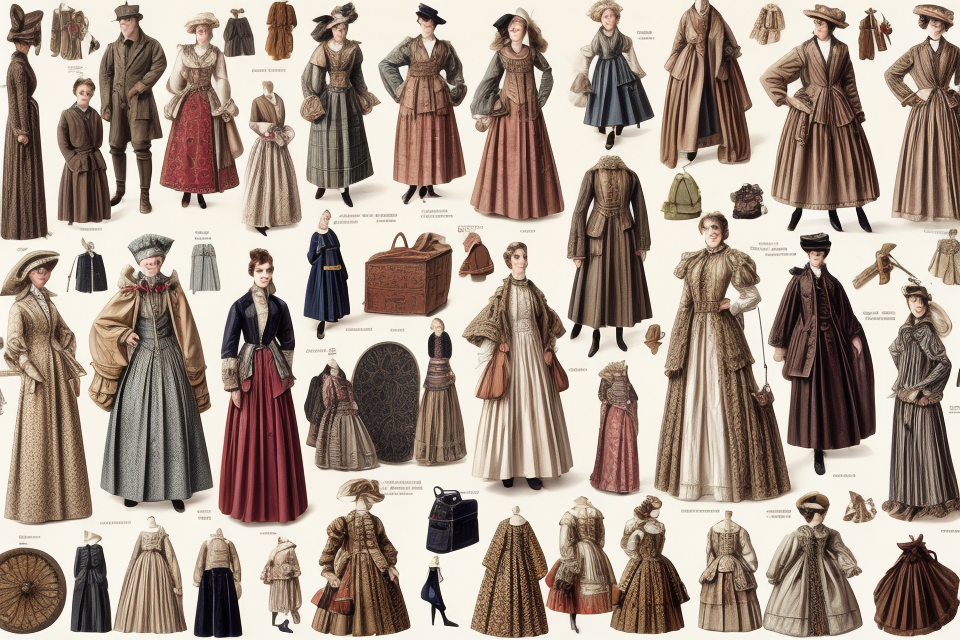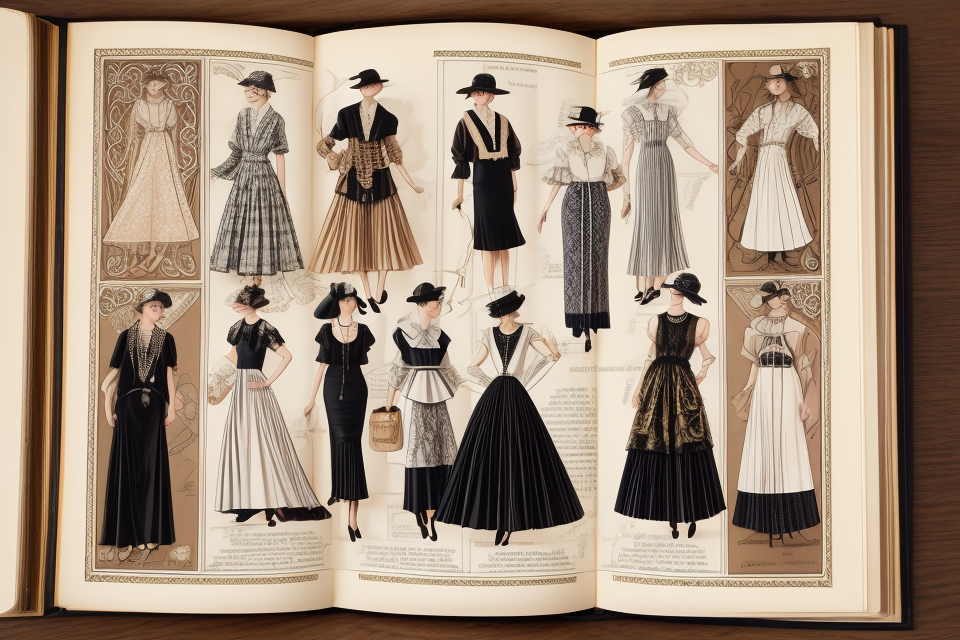
Anti-fashion, a term that might seem paradoxical, has a rich and fascinating history. It is a movement that challenges conventional norms of fashion and encourages individuals to reject the mainstream trends. From its origins in the 1960s counterculture to its resurgence in the modern era, anti-fashion has been a powerful force in shaping the way we think about style and self-expression. This topic will delve into the history of anti-fashion, exploring its roots, key figures, and impact on the fashion industry. Join us as we explore the rebellious and creative spirit of anti-fashion and how it continues to inspire and influence the world of fashion today.
Anti-fashion is a term used to describe a movement or trend that goes against the mainstream fashion industry. It can include styles that are considered to be unconventional, rebellious, or counter-cultural. The history of anti-fashion can be traced back to various cultural and social movements throughout history, such as the hippie movement of the 1960s and 1970s, which promoted a more relaxed and individualistic approach to dress. More recently, anti-fashion has been associated with streetwear and urban fashion, which often incorporates elements of sportswear, military fashion, and vintage clothing. The anti-fashion movement has also been influenced by the DIY (do-it-yourself) ethos, which encourages people to create their own unique styles rather than following mainstream fashion trends. Overall, the history of anti-fashion is one of resistance and rebellion against mainstream fashion norms, and it continues to evolve and influence fashion culture today.
Origins of anti-fashion
===========================
The concept of anti-fashion dates back to the early 20th century, as a reaction against the conformity and commercialization of fashion. It was a movement that emerged as a form of protest against the mainstream fashion industry, which was seen as promoting a narrow and limiting definition of beauty and style.
One of the earliest forms of anti-fashion was the hippie movement of the 1960s and 1970s. Hippies rejected the mainstream values of their time, including the fashion industry’s emphasis on consumerism and conformity. They embraced a more free-spirited and individualistic approach to dress, favoring comfortable and colorful clothing, often made from natural fabrics.
Another influential anti-fashion movement was the punk movement of the late 1970s and early 1980s. Punk fashion was a deliberate rejection of the mainstream fashion industry, with its emphasis on luxury and status symbols. Punk fashion was characterized by its raw, DIY aesthetic, with ripped and safety-pinned clothing, bondage gear, and brightly colored mohawks.
In the 1990s, the grunge movement emerged as a response to the excesses of the 1980s. Grunge fashion was characterized by its casual, worn-out look, with flannel shirts, ripped jeans, and Doc Marten boots. This movement was a reaction against the glossy, airbrushed image of fashion magazines, and celebrated a more authentic, imperfect look.
In recent years, the rise of social media has given new momentum to the anti-fashion movement. The normcore trend, which emerged in 2013, was a deliberate rejection of the pressure to conform to fashion trends. Normcore fashion was characterized by its plain, unisex, and functional look, with items like white t-shirts, khakis, and cargo shorts.
Today, the anti-fashion movement continues to evolve and adapt to new cultural and social contexts. Whether it takes the form of sustainable fashion, vintage clothing, or streetwear, the spirit of anti-fashion remains the same: to challenge the dominant fashion industry and promote a more inclusive, individualistic, and sustainable approach to dress.
Early examples of anti-fashion
The dandy in the 19th century
The dandy was a man who dressed in an extravagant and fashionable manner in the 19th century. They were known for their attention to detail, with an emphasis on tailoring and accessories. The dandy movement was a form of anti-fashion because it rejected the traditional norms of men’s fashion at the time, which was often more utilitarian and less focused on appearance. The dandy was seen as a rebel, pushing the boundaries of what was considered acceptable for men to wear.
The hippie movement in the 1960s
The hippie movement in the 1960s was another early example of anti-fashion. Hippies rejected the mainstream values of their time, including those related to fashion. They sought to create a new culture that was free from the constraints of traditional society, and this included their clothing choices. Hippies often wore bright, colorful, and flowing garments, such as tie-dye t-shirts and bell-bottom jeans. They also favored natural materials, such as cotton and hemp, and often made their own clothing. The hippie movement was a form of anti-fashion because it rejected the mainstream fashion of the time, which was often more conservative and formal. Instead, hippies embraced a more free-spirited and individualistic approach to dress.
The influence of politics on anti-fashion
- The role of punk in the 1970s
Punk emerged as a response to the mainstream fashion of the time, which was seen as conformist and materialistic. Punk’s anti-establishment message and DIY ethos encouraged people to reject the norms of society and express themselves through their clothing and style. Punk’s influence on anti-fashion can be seen in the way it inspired alternative subcultures, such as goth and emo, which also rejected mainstream fashion and created their own unique styles. - The anti-establishment message of grunge in the 1990s
Grunge emerged as a response to the excesses of the 1980s and the mainstream fashion of the time, which was seen as shallow and materialistic. Grunge’s anti-establishment message and DIY ethos encouraged people to reject the norms of society and express themselves through their clothing and style. Grunge’s influence on anti-fashion can be seen in the way it inspired alternative subcultures, such as riot grrrl and emo, which also rejected mainstream fashion and created their own unique styles. Additionally, Grunge also challenged the mainstream beauty standards by embracing a more casual and comfortable look, and encouraged people to express themselves through their clothing and style.
Evolution of anti-fashion
============================
The history of anti-fashion dates back to the early 20th century, where it emerged as a reaction against the conformity and commercialization of fashion. Anti-fashion can be seen as a form of resistance to mainstream fashion trends, and it has evolved over time to encompass a wide range of styles and philosophies.
One of the earliest forms of anti-fashion was the hippie movement of the 1960s and 1970s. Hippies rejected the materialism and consumerism of mainstream culture, and instead embraced a more natural and free-spirited lifestyle. They rejected traditional fashion norms, favoring bright colors, flowing fabrics, and handmade clothing.
Another significant evolution of anti-fashion was the punk movement of the late 1970s and early 1980s. Punk fashion was a direct rejection of the mainstream fashion of the time, which was seen as pretentious and elitist. Punk fashion was characterized by its raw, DIY aesthetic, with torn clothes, safety pins, and provocative slogans.
In the 1990s, the grunge movement emerged as a reaction against the excess and glamour of the 1980s. Grunge fashion was characterized by its deliberately unkempt and disheveled look, with oversized flannel shirts, ripped jeans, and sneakers.
More recently, the rise of streetwear has had a significant impact on the fashion industry, and has been embraced by many as a form of anti-fashion. Streetwear is characterized by its bold, graphic-heavy designs, and its emphasis on comfort and functionality over traditional fashion norms.
Overall, the evolution of anti-fashion has been driven by a desire to challenge conventional fashion norms and to express individuality and rebellion through clothing.
The impact of social media on anti-fashion
The advent of social media has significantly impacted the world of fashion, including the evolution of anti-fashion. With the rise of street style blogs and the influence of Instagram on fashion trends, anti-fashion has gained a new platform to showcase its message and reach a wider audience.
The rise of street style blogs
Street style blogs have been around since the early 2000s, but they have experienced a surge in popularity in recent years. These blogs focus on documenting the style of individuals on the streets, often showcasing unique and unconventional fashion choices. Street style blogs have played a significant role in popularizing anti-fashion by providing a platform for individuals to express their personal style and challenge traditional fashion norms.
The influence of Instagram on fashion trends
Instagram has become a powerful force in the fashion industry, with influencers and celebrities using the platform to showcase their outfits and style. This has led to a shift in the way fashion trends are established, with Instagram often dictating what is “in” and what is “out.” Anti-fashion has embraced this new platform, using Instagram to showcase its message and promote its unique perspective on fashion.
In addition to showcasing individual style, Instagram has also facilitated the rise of “anti-fashion” influencers, such as Vivienne Westwood and Rick Owens, who have gained a significant following by challenging traditional fashion norms and promoting their own unique aesthetic.
Overall, the impact of social media on anti-fashion cannot be overstated. By providing a platform for individuals to express their personal style and challenge traditional fashion norms, social media has played a significant role in the evolution of anti-fashion and its growing popularity.
The blurring of the lines between fashion and anti-fashion
The lines between fashion and anti-fashion have become increasingly blurred over time, with both styles often intersecting and influencing one another. This has led to a shift in the way individuals approach their personal style, as well as the way fashion brands and designers approach their collections.
One example of this blurring of lines is the popularity of normcore. Normcore is a style that is characterized by wearing everyday, non-descript clothing, such as t-shirts, jeans, and sneakers. This style is often seen as a reaction against the fast-paced and trend-driven nature of fashion, as well as a rejection of the idea that one’s clothing should be a reflection of their personal identity.
Another example of the blurring of lines between fashion and anti-fashion is the resurgence of retro and vintage styles. This trend has seen a rise in the popularity of clothing from past decades, such as 1980s neon colors and 1950s-inspired silhouettes. While these styles may have been originally considered anti-fashion, they have now become mainstream and are often seen as a form of nostalgia for past eras.
Overall, the blurring of the lines between fashion and anti-fashion has led to a more diverse and inclusive approach to personal style, as well as a greater focus on individuality and self-expression.
Anti-fashion today
A brief overview
Anti-fashion is a term used to describe a form of resistance to mainstream fashion trends. This resistance can take many forms, from rejecting traditional fashion norms to creating clothing that is intentionally unwearable or even offensive. Anti-fashion is often associated with countercultural movements and is seen as a way to challenge the status quo and push boundaries.
The origins of anti-fashion
The roots of anti-fashion can be traced back to the 1960s and 1970s, when young people began to reject the conservative fashion of their parents’ generation. This rejection was often tied to broader social and political movements, such as the civil rights movement, the women’s movement, and the anti-war movement.
During this time, anti-fashion became a way for individuals to express their dissatisfaction with mainstream society and to assert their independence. The fashion of this era was often characterized by bold colors, unconventional materials, and DIY (do-it-yourself) aesthetics.
The rise of anti-fashion in the digital age
With the rise of social media and the internet, anti-fashion has become more accessible and widespread. Today, anti-fashion is often associated with the avant-garde and is seen as a way to push the boundaries of what is considered fashionable.
One example of anti-fashion in the digital age is the “ugly fashion” trend, which features clothing that is intentionally unattractive or unflattering. This trend has gained popularity on social media platforms such as TikTok and Instagram, where users post videos and photos of themselves wearing oversized clothing, clashing patterns, and unusual accessories.
Another example of anti-fashion in the digital age is the “normcore” trend, which involves wearing everyday clothing in a deliberately unremarkable way. This trend has been associated with a rejection of the idea that fashion should be about status or conspicuous consumption, and instead emphasizes a more democratic and inclusive approach to dress.
Anti-fashion as a form of activism
In recent years, anti-fashion has become more closely associated with activism and social justice. Many designers and fashion brands have used their platforms to draw attention to issues such as climate change, racism, and gender inequality.
For example, in 2019, the fashion brand Eileen Fisher launched a campaign called “Renewal Workwear,” which featured clothing made from sustainable materials and designed to be durable and long-lasting. The campaign was intended to promote the idea that fashion can be both stylish and sustainable, and to encourage consumers to think more critically about the impact of their purchasing decisions.
Similarly, in 2020, the fashion brand Gucci launched a campaign called “Gucci Changemakers,” which aimed to support and amplify the voices of marginalized communities. The campaign featured a range of activists and influencers, including transgender model and activist Jaida Essence Hall and the Black Lives Matter founder Patrisse Cullors.
Overall, anti-fashion today is a complex and multifaceted phenomenon that reflects broader cultural and social trends. Whether it takes the form of unconventional fashion, DIY aesthetics, or activism, anti-fashion remains a powerful way for individuals to express their values and beliefs and to challenge the status quo.
The impact of sustainability on fashion
The modern anti-fashion movement has been greatly influenced by the growing concern for sustainability in the fashion industry. As consumers have become more aware of the environmental and social impact of their purchases, the demand for eco-friendly and ethical fashion has risen. This has led to a push for more sustainable practices in the fashion industry, from using organic materials to reducing waste.
One of the key trends in sustainable fashion is the rise of eco-friendly and ethical fashion. This includes brands that use sustainable materials, such as organic cotton and recycled polyester, and practices that minimize the environmental impact of their production processes. For example, some brands are using solar power to run their factories, while others are using water-saving technologies to reduce their water usage.
Another trend in sustainable fashion is the push for minimalism and slow fashion. This means that consumers are increasingly choosing to buy fewer, higher-quality items that will last longer, rather than following the fast fashion trend of buying new items every season. This approach not only reduces the environmental impact of fashion, but also encourages consumers to think more carefully about the items they purchase and the impact they have on the environment.
Overall, the impact of sustainability on fashion has led to a shift in the industry towards more eco-friendly and ethical practices. As consumers continue to demand more sustainable options, it is likely that the fashion industry will continue to evolve and become more environmentally friendly.
The influence of celebrity culture on fashion
Celebrity culture has had a significant impact on fashion trends in recent years. With the rise of social media, celebrities have become influencers, and their fashion choices have a significant impact on what people wear. Here are some of the ways in which celebrity culture has influenced fashion:
- The impact of influencers on fashion trends
Influencers, whether they are celebrities or not, have a significant impact on fashion trends. With the rise of social media, people are more likely to follow the fashion choices of influencers, and this has led to a greater focus on trend-based fashion. Influencers often have large followings, and their endorsement of a particular fashion trend can lead to a surge in popularity for that trend.
For example, when the Kardashian family wears a particular fashion trend, it can quickly become popular among their followers. This has led to a greater focus on trend-based fashion, rather than classic, timeless pieces. Influencers have also played a role in making fashion more accessible to the general public.
- The rise of fashion as a form of self-expression
Celebrity culture has also contributed to the rise of fashion as a form of self-expression. Many people look to celebrities as a source of inspiration for their own fashion choices, and they may choose to wear certain items of clothing or follow particular fashion trends in order to express their own personal style.
Celebrities have also helped to break down barriers when it comes to fashion. In the past, certain fashion choices were seen as being off-limits to certain groups of people, but celebrities have helped to make these choices more mainstream. For example, men wearing skirts or dresses has become more accepted in recent years, thanks in part to the influence of celebrities such as Billy Porter and Jaden Smith.
Overall, celebrity culture has had a significant impact on fashion trends in recent years. Influencers have played a role in making fashion more accessible to the general public, while celebrities have helped to break down barriers when it comes to fashion choices.
FAQs
1. What is anti-fashion?
Anti-fashion is a movement that rejects traditional fashion norms and values. It is characterized by the rejection of mainstream fashion trends and the promotion of a more individualistic and alternative approach to personal style.
2. When did the anti-fashion movement begin?
The anti-fashion movement began in the 1960s and 1970s, as a reaction against the conformity and materialism of the post-war period. It was influenced by the counterculture movement and the rise of alternative lifestyles, such as hippie and punk subcultures.
3. Who were some of the key figures in the anti-fashion movement?
Some of the key figures in the anti-fashion movement included designers such as Vivienne Westwood and Malcolm McLaren, who were known for their provocative and rebellious designs. Other notable figures included fashion writers and journalists, such as Susan Sontag and Glenn O’Brien, who challenged traditional fashion norms and promoted a more critical and analytical approach to fashion.
4. What were some of the key styles and trends of the anti-fashion movement?
Some of the key styles and trends of the anti-fashion movement included the use of non-traditional materials, such as rubber and plastic, and the incorporation of elements from different cultures and subcultures. There was also a focus on DIY fashion, with people creating their own clothing and accessories using found materials. Additionally, there was a strong emphasis on individuality and self-expression, with people using fashion as a way to express their unique personal style.
5. How has the anti-fashion movement evolved over time?
Over time, the anti-fashion movement has evolved and expanded to include a wider range of styles and ideas. Today, there is a greater focus on sustainability and ethical fashion, as well as a continued emphasis on individuality and self-expression. The movement has also become more inclusive, with people of all ages and backgrounds embracing anti-fashion values and ideas.


